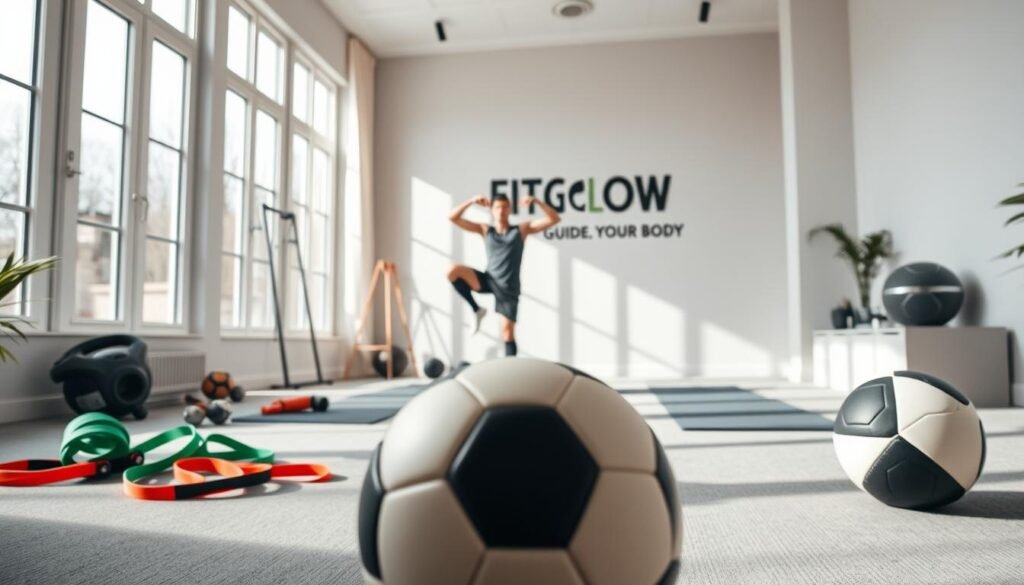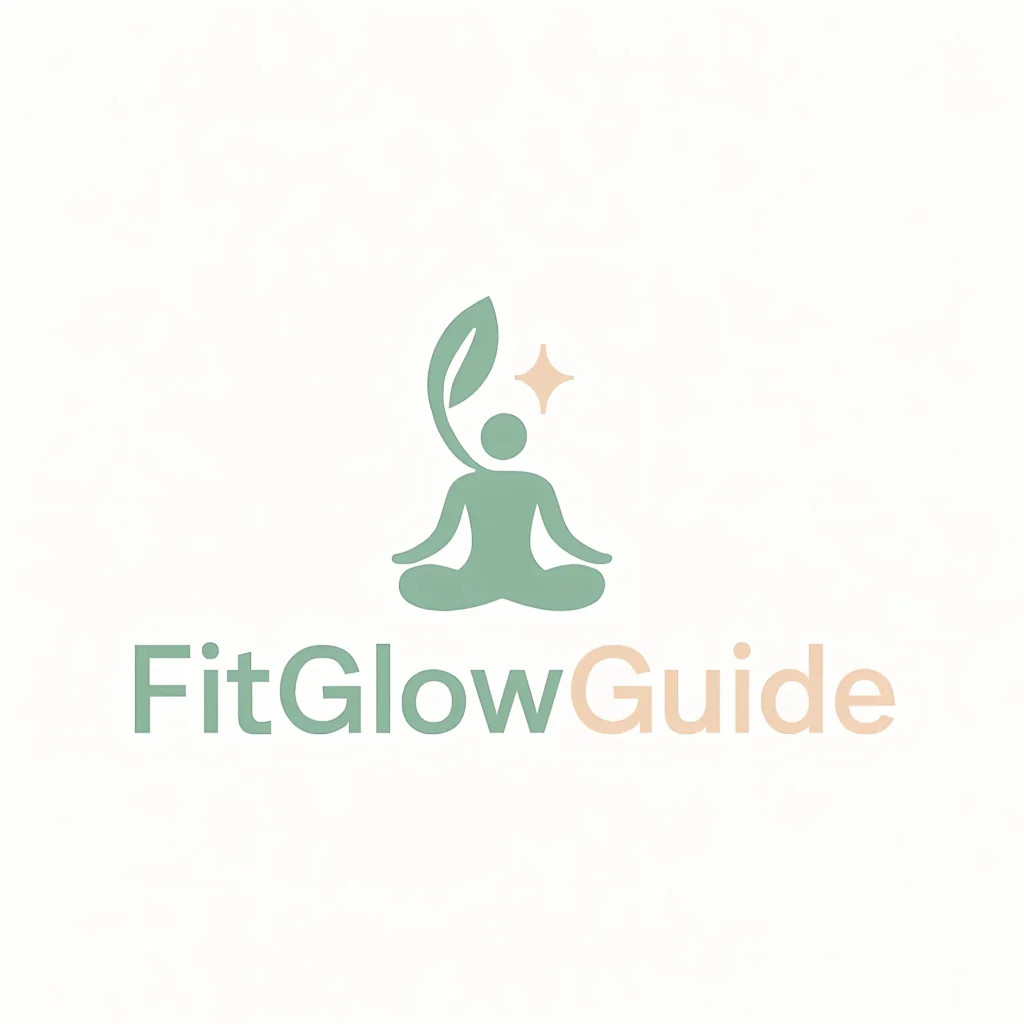A staggering 90 minutes is the average duration of a soccer match, demanding peak physical condition from players. To be match-ready, soccer players must undergo rigorous training to enhance their performance and avoid fatigue.
With the Fit Glow Guide principles, you can achieve professional-level fitness from the comfort of your home. This comprehensive guide will walk you through soccer workouts that improve power, strength, speed, agility, and endurance, directly translating to better on-field performance.
By focusing on specific muscle groups and energy systems used during a match, these workouts ensure you’re prepared for the physical demands of competitive play, helping you become a better player.
Key Takeaways
- Develop a professional-level training regimen at home with minimal equipment.
- Improve soccer-specific fitness aspects: power, strength, speed, agility, and endurance.
- Target specific muscle groups and energy systems used during a 90-minute match.
- Enhance your body’s natural athletic abilities for sustainable fitness improvements.
- Elevate your soccer skills with the Fit Glow Guide principles.
Why Soccer-Specific Fitness Matters
Achieving peak performance in soccer requires a tailored fitness regimen that addresses the sport’s unique demands. Soccer players need to be in top physical condition to excel on the field, and this involves more than just general fitness.

To understand why soccer-specific fitness is crucial, it’s essential to consider the physical demands of the game. Explosive power, muscular endurance, core strength, lower body strength, and cardiovascular fitness are all critical components.
Benefits of Home Training for Soccer Players
Training at home offers soccer players the flexibility and convenience needed to maintain and improve their fitness levels. Home training allows players to focus on their strength and power without the need for extensive equipment.
| Component | Importance | Example Exercise |
|---|---|---|
| Explosive Power | Winning aerial duels, powerful shots | Box Jumps |
| Muscular Endurance | Maintaining technical precision | High-Intensity Interval Training (HIIT) |
| Core Strength | Stability, injury prevention | Planks |
Key Physical Components for Soccer Excellence
The key physical components for soccer excellence include lower body strength, which directly correlates with shooting power and resistance to common soccer injuries, and cardiovascular fitness, enabling players to maintain high-intensity efforts throughout a match. Soccer players who develop these components can significantly improve their overall performance.
Essential Equipment for Home Soccer Workouts
Effective soccer training isn’t limited by the space or equipment you have at home. You can achieve a great workout with minimal investment.
No-Equipment Options
Bodyweight exercises are a great way to start your soccer workouts at home. You can do push-ups, squats, lunges, and planks to improve your overall fitness.
Affordable Training Tools
For those looking to add variety, affordable tools like resistance bands, jump ropes, and a good pair of running shoes can enhance your training. Fartlek training, which involves varying your running speed, is also effective.
Creating Space for Effective Workouts
Even small living spaces can be used effectively by focusing on movements that require minimal square footage. Outdoor areas like driveways or nearby parks can also be utilized.
| Equipment | Benefits |
|---|---|
| Resistance Bands | Improves strength and flexibility |
| Jump Rope | Enhances cardiovascular fitness |
| Running Shoes | Supports running and agility drills |

Explosive Power Training for Soccer Players
Building explosive power is essential for soccer athletes to improve their overall performance. Although soccer is a game that relies on speed and agility, having strong legs and core will help you be a better player. Strong and powerful legs are helpful in making quick changes in direction, while a strong core will help you make tackles and jump for headers.
Box Jump Variations
Box jump variations are an effective way to improve explosive power. By incorporating different box heights and techniques, such as single-leg jumps, you can target various muscle groups. This helps in developing the leg strength needed for powerful kicks and quick sprints on the field.
Plyometric Exercises for Soccer Power
Plyometric exercises, such as jump squats and box jumps, are crucial for enhancing soccer power. These exercises focus on the muscles used in soccer, improving your ability to explosively accelerate and decelerate. Incorporating plyometrics into your training regimen can significantly enhance your on-field performance.
Building Leg Strength for Powerful Kicks
To achieve powerful kicks, it’s essential to build leg strength. Unilateral strength exercises, such as single-leg squats, help develop the stabilizing muscles needed for kicking while addressing common imbalances. Progressive overload principles should guide strength development, ensuring that your strength improves over time.
By focusing on the posterior chain, including hamstrings, glutes, and lower back, you can generate more power in your kicks. Additionally, incorporating hip mobility work and eccentric strength training can enhance your kicking motion, making it more effective and powerful in soccer games.
Soccer Workouts at Home: Strength Building Routine
To excel in soccer, players must incorporate a comprehensive strength training regimen into their workout routine. This not only enhances their performance on the field but also reduces the risk of injury.
Lower Body Strength Exercises
Lower body strength is crucial for soccer players, enabling them to sprint, jump, and maintain stability throughout the game. Effective exercises include:
Squats and Lunges for Soccer Players
Squats and lunges are foundational exercises that target the quadriceps, hamstrings, and glutes. These exercises improve a player’s ability to explosively accelerate and decelerate on the field.
Single-Leg Exercises for Balance and Power
Single-leg exercises, such as single-leg squats and deadlifts, enhance balance, stability, and unilateral strength. This is critical for soccer, where players often use one leg to control and strike the ball.
Core Strength for Soccer Stability
A strong core is essential for maintaining stability and generating power during soccer movements. Exercises like planks, Russian twists, and leg raises can significantly improve core strength, contributing to better overall fitness and performance.
Upper Body Training for Complete Soccer Fitness
Upper body strength is often overlooked in soccer training but is vital for shielding the ball, winning headers, and maintaining posture during physical challenges. Incorporating exercises like push-ups, pull-ups, and bench press can enhance upper body strength. For instance, the bench press is an effective exercise for building upper body strength; lie down on a bench with your feet on the floor, lift a barbell above your chest until your arms are straight, and then slowly lower it back down to your chest and repeat.

By incorporating these strength building exercises into a home workout routine, soccer players can improve their overall fitness and strength, leading to enhanced performance on the field.
Speed and Agility Drills Without a Field
Agility and speed are key components of soccer fitness that can be developed at home. With a little creativity, you can replicate soccer agility drills without needing a professional field.
Cone Drill Alternatives at Home
While cones are ideal for agility drills, you can create alternatives at home. Use small objects like water bottles or books to set up a course. Practice weaving through these objects to improve your agility and reaction time. This simple setup can help you develop the quick changes of direction needed in soccer.
Ladder Drills for Footwork Precision
An agility ladder is a valuable tool for improving footwork, and you can even create a homemade version using tape, rope, or chalk on a driveway. Ladder drills enhance foot speed and coordination. Start with basic patterns like “two feet in, two feet out” and progress to more complex movements. Lateral movements through the ladder improve side-to-side agility, crucial for defensive positioning.
To perform ladder drills, set up the ladder on the ground and face the first box. Step into the first box with both feet, then step out. Repeat this process, moving laterally through the entire ladder. This drill improves your footwork precision and agility. As you master basic patterns, increase the complexity to challenge your coordination under fatigue.
Endurance Training for 90-Minute Performance
To perform at their best during a 90-minute soccer match, players need to focus on building their endurance. Endurance training is crucial for soccer players as it enables them to maintain their performance level throughout the game.
High-Intensity Interval Training (HIIT) for Soccer
High-Intensity Interval Training (HIIT) is a highly effective method for improving soccer endurance. It involves short bursts of high-intensity exercise followed by brief periods of rest. This type of training simulates the intensity of a soccer match, helping players build the stamina needed for 90 minutes of continuous play. For example, a HIIT workout might include 30 seconds of sprinting followed by 30 seconds of jogging.
Building Soccer-Specific Stamina
Building soccer-specific stamina involves a combination of cardiovascular exercises and strength training. Fartlek training, which involves varying your running speed, is particularly effective. It simulates the unpredictable intensity changes experienced during a soccer match. Other methods include progressive distance runs to build aerobic base, tempo runs at threshold pace to develop lactate tolerance, and recovery-focused sessions like light jogging or swimming to accelerate adaptation between higher-intensity training days.
| Training Method | Description | Benefits |
|---|---|---|
| Fartlek Training | Mixing continuous running with short periods of fast running | Simulates match intensity changes |
| Progressive Distance Runs | Gradually increasing running distance | Builds aerobic base for 90-minute matches |
| Tempo Runs | Running at threshold pace | Develops lactate tolerance |
By incorporating these training methods into their regimen, soccer players can improve their endurance and stamina, enhancing their overall performance during a match that lasts 90 minutes.
Creating Your Complete Home Soccer Training Program
Creating a complete home soccer training program requires a balanced approach that incorporates strength, power, speed, agility, and endurance work. The Fit Glow Guide approach to program design achieves this balance while preventing overtraining through strategic periodization.
A well-structured soccer training program integrates various physical components in appropriate proportions based on individual needs. This includes workouts tailored to enhance strength, power, speed, agility, and endurance. Proper training also involves sound recovery principles, avoiding consecutive days of similar high-intensity work.
To maximize effectiveness, it’s essential to include proper warm-up and cool-down protocols, as well as regular assessment and program adjustment. As a soccer player, individualizing your program based on position-specific demands, personal weaknesses, and recovery capacity is crucial. By doing so, you’ll be well on your way to achieving your training goals at home.
FAQ
What are the most effective leg exercises for building strength for powerful kicks?
Squats, lunges, and leg press are excellent exercises for building leg strength. These exercises target the quadriceps, hamstrings, and glutes, which are essential for generating power in kicks.
How can I improve my speed and agility without a large training space?
You can use ladder drills and cone drills in a smaller space, such as a living room or backyard. These drills can help improve your footwork, reaction time, and overall agility.
What is the best way to incorporate plyometric exercises into my training routine?
Start with lower-intensity plyometric exercises like box jumps and progress to more advanced exercises like depth jumps. Make sure to warm up properly before starting and to focus on proper technique to avoid injury.
How often should I do strength conditioning exercises to see improvement in my game performance?
Aim to do strength conditioning exercises 2-3 times per week, focusing on different muscle groups each day. Consistency and progressive overload are key to seeing improvements in your overall strength and game performance.
Can I improve my endurance for 90-minute games without a lot of equipment?
Yes, you can improve your endurance with high-intensity interval training (HIIT) using bodyweight exercises like burpees, jump squats, and mountain climbers. These exercises can be done with minimal equipment and can be adapted to fit your fitness level.
How can I ensure I’m using proper technique when doing box jumps and other plyometric exercises?
Focus on proper landing technique, bending your knees to absorb the impact, and exploding upward from the box. It’s also a good idea to watch videos or work with a trainer to ensure you’re using proper form.













